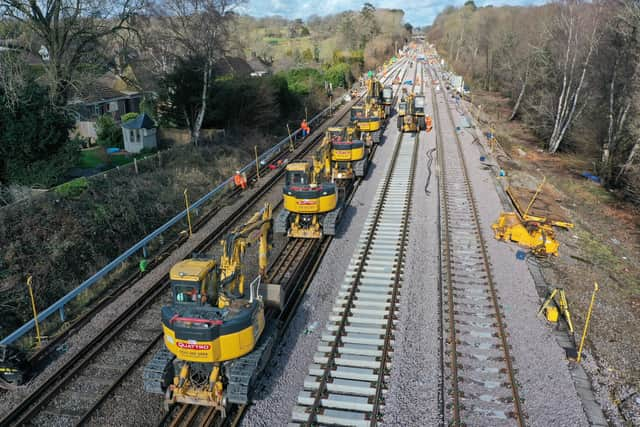Brighton Main Line reopens after Network Rail delivers £15m improvements
and live on Freeview channel 276
During this period, which began on Friday (February 18) and ended on Sunday (February 27), Network Rail engineers battled Storm Eunice and Storm Franklin to deliver a £15 million investment across 30 worksites.
The goal was to improve journeys for Brighton Main Line passengers.
Advertisement
Hide AdAdvertisement
Hide Ad

“Dealing with the worst storms we’ve seen in years was a massive challenge,” said Katie Frost, Network Rail’s route director for Sussex.
“But our teams battled through and worked more than 35,000 hours to deliver £15 million of investment at more than 30 work sites, and handed back the railway on time for trains to run again on Monday morning,” she said.
Katie added: “We are really grateful to people who had to manage longer journeys and changes to services, and also our railway neighbours who have experienced nine days of major engineering work next to their homes.”
Advertisement
Hide AdAdvertisement
Hide AdShe said the recent work will deliver ‘vital safety and reliability benefits’ for passengers on one of the UK’s busiest and most congested routes.
Katie added that the extended closure allowed Network Rail to avoid the alternative of 20 weekends of disruption on the line.
During the blockade, Network Rail worked with Southern and Thameslink to run bus replacement services.
Advertisement
Hide AdAdvertisement
Hide AdChris Fowler, customer services director for Southern, said: “We’ve worked hard to keep people moving during the work, with special diverted trains and up to 50 buses an hour running from a huge temporary bus hub.”
“Roughly 50,000 journeys were completed by bus, and 100 extra customer services staff have helped to make those journeys as smooth as possible,” said Chris.
“We’re very grateful to all our customers for your patience, whether you travelled with us or made other arrangements,” he added.
Chris said the work will improve service reliability for customers across the South East well into the future and that direct services between Brighton and London Victoria have resumed.
Advertisement
Hide AdAdvertisement
Hide AdNetwork Rail’s improvements included using 8,000 tonnes of ballast and 1,500m of new track to rebuild a crucial rail junction controlling the movement of trains in and out of Brighton and the Ardingly freight branch.
They upgraded track at Burgess Hill and Clayton tunnel too.
Network Rail also removed 4,500 tonnes of earth from the railway embankment at Hassocks and 24 concrete sections were lifted into place to create an underpass to give people safe access under the railway.
This new underpass at Hassocks replaces the old Woodside pedestrian crossing.
Network Rail said that about 500m of reinforced protective walls and more than 1,000 soil nails were used to stabilise around 1km of embankment at Haywards Heath, Balcombe and Hassocks and one cutting at Lewes.
Advertisement
Hide AdAdvertisement
Hide AdThe work will protect passengers from delays caused by landslips, they said.
Drainage was rebuilt in the Balcombe tunnel to stop flooding and water build-up, while in the Clayton tunnel, 200m of brickwork was repaired to prevent leaks and stop loose bricks falling onto the railway.
The removal of scrub and non-native species, as well as the reseeding of areas with native wildflowers, got underway at Haywards Heath, Wivelsfield, Burgess Hill and Hassocks. This is part of a railway biodiversity programme that will continue into the future.
On top of this, Network Rail said the programme to install high capacity fibre-optic cable on the Brighton Main Line ‘made great progress’.